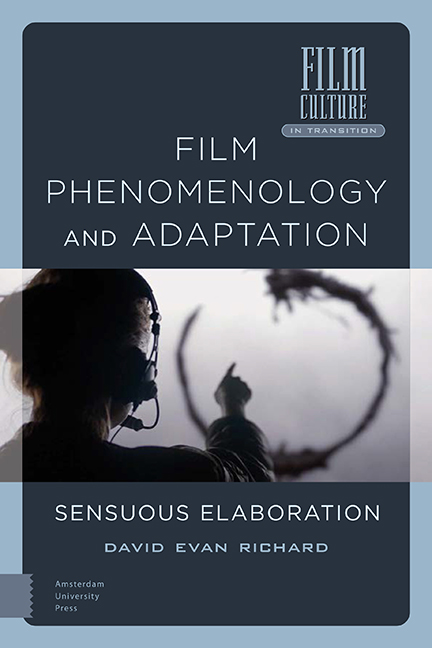Book contents
- Frontmatter
- Contents
- Acknowledgements
- List of Figures
- Introduction: A ‘Fleshly Dialogue’
- 1 Grave Visions: Visual Experience and Adaptation
- 2 Resonance and Reverberation: Sounding Out Screen Adaptation
- 3 Textural Analysis: Touching Adaptation
- 4 Textures of Imagination
- 5 (Re-)Mediating Memory’s Materiality
- Conclusion: Body Language
- Bibliography
- Filmography
- Index
1 - Grave Visions: Visual Experience and Adaptation
Published online by Cambridge University Press: 27 May 2021
- Frontmatter
- Contents
- Acknowledgements
- List of Figures
- Introduction: A ‘Fleshly Dialogue’
- 1 Grave Visions: Visual Experience and Adaptation
- 2 Resonance and Reverberation: Sounding Out Screen Adaptation
- 3 Textural Analysis: Touching Adaptation
- 4 Textures of Imagination
- 5 (Re-)Mediating Memory’s Materiality
- Conclusion: Body Language
- Bibliography
- Filmography
- Index
Summary
Abstract
Rather than approaching the ‘look’ of adaptation through point of view or the ‘vision’ of the adapter, this chapter examines the material, visible texture of screen adaptation. Using two adaptations of Bram Stoker's gothic novel Dracula, I analyse how each uses mise en scene, cinematography, and editing to thicken and make tangible Stoker's questioning of the reliability of vision in modernity. The first, Nosferatu (F.W Murnau, 1922) employs the tricks of early cinema to shock spectators, while the second—Bram Stoker's Dracula (Francis Ford Coppola, 1992)—uses a neo-baroque aesthetic that ruptures the screen and engulfs the spectator, much like one of Dracula's victims. This chapter suggests that critical insight into an adaptation can be found quite literally in sight, and embraces how the materiality of adaptation overlaps with the materiality of vision.
Keywords: vision, early cinema, cinema of attractions, adaptation, Dracula, Nosferatu
Introduction: Eye-Opener
This chapter focuses on the look of screen adaptation. At first glance, this statement might appear dull, promising to only but skim across the text's surface rather than plunge into the inner depths of the adaptation and the dynamics of its beholder's engagement. However, I argue that the (quite literal) oversight of screen adaptation's look is due to the lingering critical spectres that haunt the discipline. Specifically, I claim that critics have turned away from the sensual allure of the screen, effectively blinding themselves to what may appear as only superficial. While Film Phenomenology and Adaptation: Sensuous Elaboration aims to help return adaptation studies (and adaptation critics) to its senses, the specific task of this chapter is to reveal how critical insight is found in sight.
This chapter primarily draws on two adaptations of Bram Stoker's novel Dracula: the German Expressionist Nosferatu: A Symphony of Horror (F.W. Murnau, 1922), and Bram Stoker's Dracula (Francis Ford Coppola, 1992). The gothic tale is well-known: with the help of Jonathan Harker, Dracula—a blood-sucking Transylvanian count—moves to London and wreaks havoc on modern society. Roger Luckhurst notes that Dracula, at its core, stands as an allegory for the way that fin de siecle culture enacted a range of ‘insidious attacks’ that threatened the coherence and integrity of (Anglo-Saxon) identity.
- Type
- Chapter
- Information
- Film Phenomenology and AdaptationSensuous Elaboration, pp. 43 - 72Publisher: Amsterdam University PressPrint publication year: 2021



